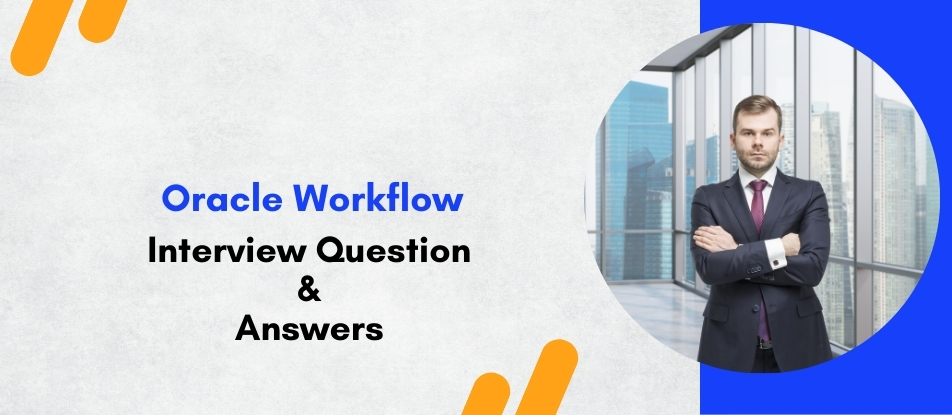
Oracle Workflow Training is designed to help professionals automate and manage business processes using Oracle Workflow tools. The course covers key topics such as item types, attributes, functions, notifications, process design, and integration with Oracle Applications. Participants will learn to build, deploy, and monitor workflows effectively. This training is ideal for Oracle developers and consultants aiming to enhance operational efficiency and improve decision-making through workflow-driven automation.
Oracle Workflow Training Interview Questions Answers - For Intermediate
1. What are transitions in Oracle Workflow and how do they work?
Transitions define the path of execution between two workflow activities. Each transition can have a condition or result code that determines whether the process should proceed to the next step. Transitions are essential for controlling the logical flow, allowing for branching, looping, or conditional routing based on business rules.
2. How do you start a workflow process programmatically?
A workflow process can be initiated programmatically using PL/SQL APIs such as WF_ENGINE.STARTPROCESS. You must specify parameters like item type, item key, process name, and initial attribute values. This approach is commonly used in custom forms or concurrent programs to trigger workflows automatically.
3. What is a Wait activity in Oracle Workflow?
A Wait activity is used to pause workflow execution until a specific condition is met, such as a defined time duration or an external event. It’s often used in workflows requiring a time delay, escalations, or integration with other systems, helping to coordinate process timing.
4. How do you troubleshoot a stuck workflow in Oracle?
Troubleshooting involves checking the workflow status in the Workflow Monitor, verifying if required concurrent programs like the Workflow Background Process have run, and reviewing database tables like WF_ITEMS or WF_ITEM_ACTIVITY_STATUSES. Restarting or forcing the workflow from the backend may be needed if it's stuck.
5. What is the significance of the Item Key in Oracle Workflow?
The Item Key is a unique identifier for each instance of a workflow process. It typically combines key attributes like document ID or user ID, ensuring each workflow can be tracked and managed independently. It is required when initiating or referencing a workflow programmatically.
6. Can one workflow call another in Oracle Workflow?
Yes, Oracle Workflow supports sub-processes. A main workflow can call a subprocess defined under the same or another item type. This modular approach promotes reusability, simplifies complex workflows, and allows for centralized updates to commonly used processes like approvals or validations.
7. What is the difference between deferred and immediate activities in a workflow?
Immediate activities are executed by the Workflow Engine as soon as the previous activity completes, while deferred activities are queued for the Workflow Background Process to handle. Deferred activities are useful for time-consuming tasks or processes that should not run during peak hours.
8. What are the common workflow-related tables in Oracle Apps?
Important workflow tables include WF_ITEMS (workflow instances), WF_ITEM_ACTIVITY_STATUSES (activity status), WF_NOTIFICATIONS (user notifications), and WF_MESSAGES (message definitions). These tables are helpful for monitoring, reporting, and troubleshooting workflow execution in Oracle Applications.
9. How are roles defined in Oracle Workflow?
Roles are used to determine who receives workflow notifications. A role can be a single user, a group of users, or a dynamic role determined through custom logic. Roles are defined in the WF_ROLES table and can be assigned directly in the Workflow Builder.
10. What is the difference between a notification and a function in Oracle Workflow?
A function performs a backend business operation such as data processing, whereas a notification sends a message to a user for review or response. Notifications involve human interaction, while functions are executed by the system. Both are critical components of process automation.
11. How do you define response types in workflow notifications?
Response types are defined within the notification message and determine the user’s options (e.g., Approve, Reject). Each response can trigger a different transition in the workflow. These types are configured in the Workflow Builder and can include optional comments or justification fields.
12. What is the use of the Workflow Directory Services?
Workflow Directory Services is a framework that handles user and role management in Oracle Workflow. It links users to applications and ensures that notifications are routed correctly. It integrates with Oracle Applications' HRMS and FND user base for seamless access control.
13. How does Oracle Workflow support multilingual environments?
Oracle Workflow supports multiple languages by storing translatable text (e.g., messages and descriptions) in separate translation tables. These messages are displayed based on the recipient’s preferred language setting in their user profile, enhancing usability in global deployments.
14. What is a selector in Oracle Workflow and when is it used?
A selector is a PL/SQL function used to determine which process to start for a given item type. It is typically used when multiple processes exist under the same item type, and the correct one must be chosen based on runtime conditions or input parameters.
15. What are the best practices when designing Oracle Workflow processes?
Best practices include modularizing workflows using sub-processes, avoiding overly complex logic in a single flow, documenting each activity and transition clearly, testing thoroughly using test environments, and using descriptive names and comments in Workflow Builder. These practices enhance maintainability, scalability, and ease of troubleshooting.
Oracle Workflow Training Interview Questions Answers - For Advanced
1. How do you design a reusable workflow process across multiple modules in Oracle Applications?
A reusable workflow process is created by designing a modular, generic workflow under a common item type that includes configurable attributes, standard functions, and notifications. These workflows are built with flexibility in mind, where parameters like document type, approver roles, and message content are passed dynamically through attributes. Such workflows are integrated across modules by registering item types and defining interfaces that allow different modules to trigger the same process with their specific data. Reusability reduces development effort, ensures consistency in approval logic, and simplifies long-term maintenance.
2. What challenges do you face when customizing seeded Oracle workflows, and how do you manage them?
Customizing seeded workflows can be risky as it may impact future upgrades, support, and system stability. Common challenges include understanding the complex dependencies, preserving original logic, and ensuring data compatibility. To manage these, best practices include copying seeded workflows to a custom item type or process, applying changes only to the copied version, and documenting all modifications. Thorough testing in development and staging environments is essential. Maintaining version control and change logs helps ensure that custom workflows remain manageable and upgradable.
3. How does Oracle Workflow support audit compliance and regulatory reporting?
Oracle Workflow maintains comprehensive audit trails that record every significant action, including the start and end of processes, user responses to notifications, status changes, and escalations. These records are stored in dedicated workflow tables and accessible via Workflow Monitor. They include user identification, timestamps, and status values that are crucial for audit tracking. Additionally, workflow notifications can be customized to capture justifications or comments during approvals, which strengthens compliance. The system’s integration with HR and security roles further ensures traceability and accountability in regulated environments.
4. How does Oracle Workflow handle simultaneous activities and parallel branches in a business process?
Oracle Workflow supports parallel processing using subprocesses or branching logic where multiple activities can execute independently. This is useful in scenarios like multi-department approvals or concurrent validations. Each parallel path is treated as an independent thread within the workflow, and synchronization can be achieved using a join activity. This ensures that the process only continues after all branches complete or after a defined condition is met. Properly managed parallel branches enhance efficiency and allow complex workflows to reflect real-world concurrent decision-making.
5. What steps would you take to debug a workflow that is not progressing as expected?
To debug a stalled workflow, start by reviewing its status in the Workflow Monitor to identify where it is currently paused. Check if the current activity is deferred, awaiting user input, or has encountered an error. Look for any pending notifications and verify if recipients are valid and able to respond. Ensure that the Workflow Background Process has been run recently to pick up deferred or timed-out activities. Also, review workflow attribute values to confirm if necessary inputs were passed. For persistent issues, examining the workflow logs and querying the status tables helps isolate the problem.
6. What are the different types of roles in Oracle Workflow and how are they resolved at runtime?
Roles in Oracle Workflow can be static, where a specific user or group is predefined, or dynamic, where the recipient is determined at runtime based on attribute values or business logic. Static roles are straightforward and suitable for simple notifications, while dynamic roles are used when routing is based on factors like department, project, or document type. At runtime, the system uses directory services or function-based logic to resolve roles into actual users. This dynamic role resolution adds flexibility and ensures the correct recipients are engaged in each workflow instance.
7. How does Oracle Workflow interact with concurrent programs and how are these integrated into workflows?
Concurrent programs can be invoked from within Oracle Workflow using function activities designed to launch them with specific parameters. Workflows often use this integration to perform background tasks such as data updates, report generation, or external system synchronization. The workflow can wait for the concurrent program to complete before proceeding, using status checks or Wait activities. This integration allows workflows to extend beyond user approvals and include system-driven automation, enhancing the scope and utility of business processes.
8. What is the importance of workflow purging, and how is it managed in Oracle Applications?
Workflow purging is essential for maintaining system performance and managing database size, especially in environments with high transaction volumes. Completed or obsolete workflow instances accumulate in the system, leading to performance degradation. Oracle provides purge programs that safely remove historical data without affecting current workflows. Purging should be scheduled during non-peak hours and after ensuring that business or audit requirements for historical data have been met. Managing purging effectively ensures better system responsiveness and optimal use of storage resources.
9. How does Oracle Workflow enable integration with external systems?
Oracle Workflow integrates with external systems through business events, external APIs, and messaging gateways. Events can be triggered when external actions occur, prompting a workflow within Oracle Applications to begin or respond. Similarly, workflows can publish events that are consumed by external applications. This event-driven architecture allows Oracle Workflow to function as part of a broader enterprise solution. Web services and messaging interfaces allow real-time interaction, enabling seamless coordination between Oracle and non-Oracle systems.
10. What challenges do you face when designing workflows with exception handling, and how do you address them?
Designing workflows with robust exception handling is challenging because it requires anticipating possible failures and defining logical responses for each. Some workflows may face user inactivity, system errors, or invalid data scenarios. To handle these, workflows should include fallback transitions, timeouts, and error notifications. Creating branches specifically for error handling, using retry logic, and notifying administrators can prevent permanent failures. Exception handling should be tested extensively to ensure that the process remains stable even in unexpected conditions.
11. What is the use of the Workflow Open Interface in Oracle Workflow?
The Workflow Open Interface provides a way to insert workflow items and activities directly into the system from external applications or processes. It is particularly useful for integrating third-party systems or custom Oracle forms that need to initiate workflows without using the graphical Workflow Builder. Using the open interface tables, processes can be loaded and tracked within the standard Oracle Workflow framework. It offers a powerful method to expand workflow usage across varied business systems.
12. How do you control workflow access and permissions for different user levels?
Workflow access is governed through user responsibilities, roles, and security profiles within Oracle Applications. Only users with appropriate responsibilities can view or act on specific notifications. Workflow roles are used to direct notifications, and these can be tied to user groups or positions. By configuring responsibilities and menu exclusions, access to workflow features can be restricted as needed. Ensuring that only authorized users can modify or approve items enhances data integrity and process control.
13. How are Lookups used in Oracle Workflow, and what is their benefit in process design?
Lookups in Oracle Workflow are predefined lists of values that are used to represent statuses, result codes, or other options within the workflow. They allow developers to define readable, consistent values for process outcomes or decision points. For instance, approval results like “Approve” or “Reject” can be defined in a lookup, making it easier to manage transitions and message content. Using lookups enhances clarity, promotes reusability, and simplifies updates when business logic changes.
14. How does the Workflow Monitor assist administrators in managing workflow processes?
The Workflow Monitor provides a visual interface to track the execution of workflow processes. It shows current status, completed activities, pending notifications, and error points within a graphical workflow map. Administrators can drill down into activity details, retry or skip steps, and view attribute values in real time. This tool is vital for troubleshooting, performance tuning, and ensuring that business processes flow as intended. Its ability to provide transparency into running workflows makes it an essential part of system maintenance.
15. What is the role of the Workflow Background Process and why must it be scheduled correctly?
The Workflow Background Process is responsible for processing deferred and timed-out activities. It executes background tasks such as wait activities, expired notifications, and stuck transitions. Scheduling this process at appropriate intervals ensures that workflows progress smoothly without unnecessary delays. If this process is not run regularly, workflows can stall, leading to operational bottlenecks. Administrators must monitor its execution and configure it according to business workload and transaction volumes.
Course Schedule
| Apr, 2025 | Weekdays | Mon-Fri | Enquire Now |
| Weekend | Sat-Sun | Enquire Now | |
| May, 2025 | Weekdays | Mon-Fri | Enquire Now |
| Weekend | Sat-Sun | Enquire Now |
Related Courses
Related Articles
Related Interview
Related FAQ's
- Instructor-led Live Online Interactive Training
- Project Based Customized Learning
- Fast Track Training Program
- Self-paced learning
- In one-on-one training, you have the flexibility to choose the days, timings, and duration according to your preferences.
- We create a personalized training calendar based on your chosen schedule.
- Complete Live Online Interactive Training of the Course
- After Training Recorded Videos
- Session-wise Learning Material and notes for lifetime
- Practical & Assignments exercises
- Global Course Completion Certificate
- 24x7 after Training Support













 Join our Live Instructor-Led online classes delivered by industry experts
Join our Live Instructor-Led online classes delivered by industry experts